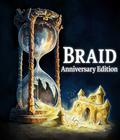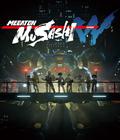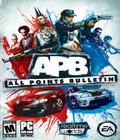All Points Bulletin fills a niche in the form of an open-world, GTA-style game in which bands of players can clash in a swirl of criminal acts and savage gunfights from speeding vehicles. While the GTA series and games of its ilk (i.e., Saints Row) certainly had multiplayer components, they just felt like specialized deathmatch. APB doesn't up the ante in that regard but applies it to a much larger and more vibrant backdrop with a persistent backend and a dizzying array of customization options.
The game is set in the fictitious city of San Paro, which is a metropolis wracked with rampant instances of criminal acts. To help stem the tide of car thefts and muggings, the mayor has put in place a controversial act that allows citizens to register as a member of the Enforcers, essentially letting them become a city-sanctioned vigilante to protect and serve the populace of San Paro by any means necessary. This, of course, just escalates the problem into all-out warfare in the streets.
Your first steps in APB take you through the character creation process. You must choose your server and side (Criminals or Enforcers) before crafting your avatar with a large selection of physical modifications and sliders. Once your newly minted crime buster or gang banger is out the gate, the game walks you through the basics via a tutorial district. This gives you just enough time to get your feet wet and learn the basics of life in San Paro before smacking you on the rear and throwing you into the game proper.
The structure of APB is tiered in a variety of levels: server, district and instance. There are two servers in the game at the time of writing, and characters made on one server are always on it and cannot transfer to the other. There are three districts — Financial, Social and Waterfront — which are further broken down into identical instances therein, each with a maximum player count of 80. You may very well find yourself in LaRocha-Waterfront-18 and surrounded by up to 79 like-minded players, and while it will look the same as instance 11 and have the same content, you will be up against a different group of players. Additional instances are added and removed for districts as needed, and players can easily hop from any district or instance to another as long as they are not currently involved in a mission.
The districts are unique, but the social district is a safe zone in which players cannot fire at each other, and it also provides a place to purchase from vendors, design a custom paint job for one of your rides, or shop in the auction system. Customization is the name of the game in this district, which is only limited by people's creativity. Cars have different stats between models — a Jericho sports car will be faster and more agile than a Han Veo four-door sedan — but vehicles can be equipped with varying amounts of cosmetic changes, such as replacement parts, and even some sound effects, such as turbo or dump valves. Your car can be painted and decorated as you see fit, thanks to a fairly comprehensive decal editor. APB includes quite a few symbols and lettering examples, but there's nothing to stop you from creating and using your own.
Your character can also be customized in a similar manner. Though clothing options are purely cosmetic and do nothing to alter your character's hit box or versatility, they allow you to make your own unique look. Articles of clothing can be mixed and matched to establish your base outfit before letting you color individual parts and use the decal editor to add some final touches. Even your character's physical traits can be altered, and though all clothing options have a price tag, expect physical alterations to cost an arm and a leg in comparison.
The game would be nothing without its action districts, however, and all of the gunplay and hot pursuits take place in the Financial and Waterfront districts. With a population cap of 80 for each instance, the title does its best to make sure that each side is balanced, but the two cannot just shoot each other in the street. In order to plug a Criminal, an Enforcer needs to catch him in the act of committing a crime or respond to an APB on him. It's a system that works surprisingly well, not only rewarding Enforcers who witness Criminals causing crimes but also making sure that Criminals don't mow down civilians or steal cars in the open if they don't want to get into altercations.
The witness system is simple enough. Any Criminal who commits a crime, from shooting a pedestrian to mowing down a stop sign, can be witnessed by nearby Enforcers. If both the Criminal and Enforcer are not currently on a mission, this immediately allows the Enforcer to make it his job to take down the Criminal. As both sides complete missions, kill opposing players, and avoid (or cause) havoc, their notoriety goes up from zero to the maximum of five. As notoriety increases, mission rewards and reputation gains do so as well, at the expense of getting more random APBs put out against you. At low notoriety, members of the opposing faction can only get APBs put out against you while you are on a mission, but at higher notoriety, even pedestrians can witness Criminals, and Enforcers will find it difficult to do anything without a Criminal coming into the mission. At a notoriety level of five, your location is marked on the map, a decent bounty is placed on your head, and almost anyone can gun for you to claim the bounty, at which point you are bumped down a peg and someone walks away a few hundred bucks richer.
The APB system also serves as the matchmaker, and while being a witness is still going to allow an experienced player to pick out a newbie for swift elimination, the APB system tries its best to match up players of like skill and experience. Players are rated on a variety of factors, the two biggest ones being the rating and threat level. Rating goes up quite high and is more or less based on time played, whereas threat level is based on the successful completion of missions and a player's kill-to-death ratio. You will occasionally be matched up against players who will wipe the floor with you or behave much like a bunch of doormats, but for the most part, the matchmaking works decently. It can fail in certain mission types, however, such as being sent into a 2v4 fight where the opposing team needs to defend an area that you must attack and you can't call for additional backup. Though your rating and threat level may be equal to their collective level, it can be difficult when stacked with those odds, even if you're fighting newbies.
Missions are varied in their wording and descriptions but essentially follow the template of "Go here and do this," usually accompanied by a progress bar. For example, if you're breaking into a house via a door or raiding a home with a battering ram, your character will use a crowbar or battering ram against the door while a circular progress bar fills up. The objectives are straightforward and simplistic, but they are merely vehicles for organized player-versus-player combat. Watching a progress bar fill up when you're alone is boring as hell, but coordinating with a group of five other Criminals to take out a group of Enforcers who have dug in to protect the objective is a different and much more enjoyable experience.
Performing missions is a great way to gain money and rep with factions and contacts, which then unlocks new clothing options, upgrades, vehicles and weapons. However, doing missions alone is incredibly mundane because they're very simplistic, and direct one-on-one combat is rarely enjoyable. APB thrives on group-versus-group combat, which is made simple thanks to the ease with which one can find or join a group by responding to an APB or using the Looking for Group tool to join one that persists after the bullets have stopped flying and the bodies have fallen.
There are numerous weapons to choose from, most of which are unlocked during gameplay. Shotguns, sniper rifles, assault rifles, machine guns, and others round out the primary weapon slot choices while machine pistols and various pistols and revolvers make up your secondary slot selection. You can also equip any number of grenades, though there is little reason to use anything other than concussive grenades unless you are an Enforcer looking to stun and not kill. You see, Enforcers get a selection of less-than-lethal weapons in their primary and secondary slots, and instead of killing Criminals, it puts them in a stunned state so they can be arrested. Arresting a Criminal yields more cash and a higher rep gain than killing him, but the act of arresting a Criminal takes time, during which the Enforcer is vulnerable. If not guarded, the Criminal can be freed while the arrest timer ticks down.
Weapon balancing is probably one of APB's biggest flaws. Though the primary weapon slot has a nice selection of weapons from various schools of range and stopping power, there is too much carryover in some of the weapons. Specifically, the OCA submachine gun (essentially an MP5) and the NTEC (essentially an AK) both have very high accuracy at longer ranges and more stopping power than a shotgun when up close. When paired with a Colby RSA revolver for the very long-range gunplay, it is a loadout that has no flaws or weak situations, so it's the most prevalent one in the game. Criminals often complain that the less-than-lethal guns are cheap because they take them out of a fight for up to 45 seconds due to all the timers involved rather than an easy sub-10-second respawn, but if Criminals stick together, it is very tough for someone to be arrested unless the entire group is wiped out.
Some of the mission types are also flawed, though much of it could be attributed to matchmaking concerns. There are some mission types where one side has limited lives and a time limit to complete an objective whereas the opposing side has neither to worry about. Escape missions also give a clear advantage to the Criminal side, as all they have to do is hop into a fast car, drive quickly, avoid slamming into things so as to not incur a time penalty, and change directions every once in a while to avoid an Enforcer pursuit while an escape bar fills up. There are enough mission types that have flaws on either side that they almost seem to balance out in that regard, but it causes some uneven gameplay and frustration when they crop up.
One chief area of concern held by many is that APB has a cost to play, depending on how you go about it. A 30-day unlimited block of time costs $9.99 or 400 RTW points, whereas it costs $6.99 or 280 RTW points for 20 hours of play. If you play more than 20 hours a month, it is more cost-effective to get a 30-day block, though any time spent in the Social district customizing your character does not count toward your remaining hours. RTW points can be purchased but can also be made and spent via the in-game auction system. For instance, if you are a player who is adept at making awesome symbols or character theme music using the game's music editor, you might be able to sell them for RTW points or in-game money, which you can then sell for RTW points.
Once you boil down all those numbers, the question remains about whether or not it's worth it. APB is certainly not an MMO in the traditional MMORPG sense, so people who are looking for a grand experience like working your way up to the Lich King or organizing a raid on Altdorf will be disappointed. However, APB takes the multiplayer gameplay reminiscent of other games of its type and expands upon it tenfold. The city isn't quite living and breathing, but it serves as an excellent backdrop for loosely organized gang warfare. Warts and all, APB has enough going for it that gamers who are looking for this type of gameplay on a larger scale will have a lot to enjoy. One hopes that some of the post-release balancing and matchmaking jitters will be ironed out enough to help the game reach its fullest potential.
Score: 8.0/10
More articles about APB: Reloaded











 All Points Bulletin (APB) is an MMO freeform combat and driving-based game. Players must decide which side of the law to abide by, as Law Enforcement who take on the challenge of supporting and safeguarding justice, or as Gangs, who operate against the law and any opposing groups by any means necessary.
All Points Bulletin (APB) is an MMO freeform combat and driving-based game. Players must decide which side of the law to abide by, as Law Enforcement who take on the challenge of supporting and safeguarding justice, or as Gangs, who operate against the law and any opposing groups by any means necessary.











































